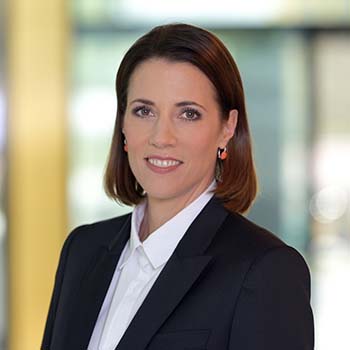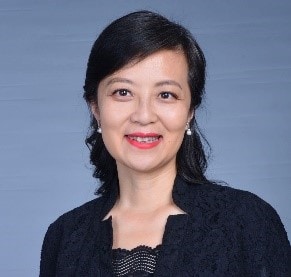
The postgenerational workforce From millennials to perennials
11 minute read
15 May 2020
Looking beyond generation to segment the workforce according to individual behaviors, values, and attitudes can help organizations to meet workers’ needs and expectations in ways that are more meaningful to them and more beneficial to the enterprise.
2021 Global Human Capital Trends
Sign up to receive a copy of our new approach to Trends launching this winter
Organizations have leaned heavily on workers’ age and generation to help inform and differentiate their talent strategies. But today’s workforce is more complex than ever, making any single demographic lens of limited value. Forward-looking organizations are shifting their approach in an effort to better understand the workforce’s attitudes and values, while harnessing technology to analyze and create new, more relevant insights into workers’ needs and expectations. Based on these insights, organizations have an opportunity to design and implement workforce strategies and programs that are more targeted toward workers’ individual attributes. This personalization enables workers to maximize their contribution at work, derive enhanced meaning in their careers, and, ultimately, better align themselves with the purpose of the organization—one which not only understands what they can contribute, but also how they uniquely can do so.
The Readiness Gap: Seventy percent of organizations say leading multigenerational workforces is important or very important for their success over the next 12–18 months, but only 10 percent say they are very ready to address this trend.
Learn more
Explore the Human Capital Trends collection
Watch the video
Learn about Deloitte's services
Order a copy of Work Disrupted, Deloitte's new book on the accelerated future of work
Explore 5 lessons from the pandemic for the future of work
Go straight to smart. Get the Deloitte Insights app
Create a custom PDF
Current drivers
For many years, age and generation has been a popular lens through which many organizations have viewed their workforce. More than half of this year’s survey respondents (52 percent) say they consider generational differences to some or a great extent when designing and delivering workforce programs. But as the workforce grows more complex, generational differences may not be the right anchor point. Today’s workforce spans five generational categories, with Generation Z, the United States’ largest demographic cohort at more than 90 million strong, about to join in.1 Only 6 percent of our survey respondents strongly agree that their leaders are equipped to lead a multigenerational workforce effectively. This raises the question of whether traditional workforce segmentation approaches, anchored in generation, should remain the focus of future workforce strategies.
The concept of “perennials,” first articulated by Gina Pell, captures the increasing importance of moving beyond broad demographic categories to understand people on a more meaningful level. As Pell puts it, “Perennials … describe[s] an ever-blooming group of people of all ages, stripes, and types who transcend stereotypes and make connections with each other and the world around them.” These are “people of all ages who continue to push up against their growing edge, always relevant, and not defined by their generation.”2
Why is generation becoming less relevant as a way to understand the workforce? The starting point is that careers have become more dynamic and complex, loosening the historic correlation between age and career progression. Rapid technological and organizational change means that workers must now reinvent themselves multiple times throughout their working lives; at the same time, the broader business culture has shifted to make it acceptable, sometimes even desirable, to promote younger individuals into leadership positions. The upshot is that 65-year-old interns can today be found working side by side with 25-year-old managers, calling into question the assumption that age is a reasonable proxy for understanding people’s workplace challenges and needs.
The diminishing relevance of generation is also being supported by the fact that all workers are becoming more vocal about their needs—and those needs, it turns out, are more similar than many may have previously thought. Many preferences once associated with millennials—from the desire to work for an employer that reflects their values to the preference for flexible schedules—hold true across all generations.
In fact, the deeper we dug into generational differences in our research, the more they disappeared. Despite the fact that 59 percent of our 2020 survey respondents agreed with the general statement that generational differences were expanding, when we dug deeper on attributes that relate to careers, we found the exact opposite in areas such as work-life flexibility, expectations of loyalty and job security, and expectations of advancement (figure 1).
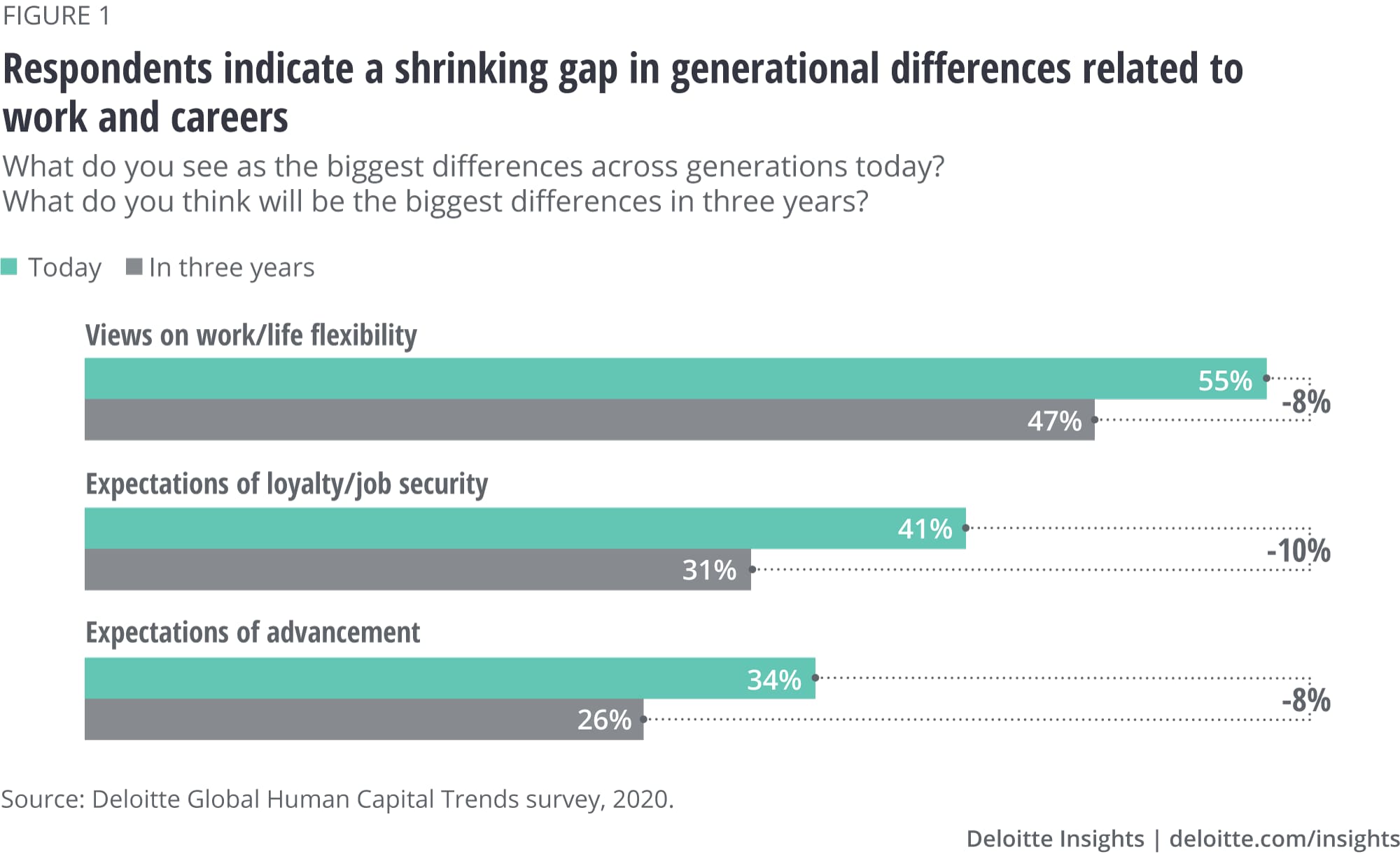
Leading generational expert Lindsay Pollak put it well in her 2019 book The Remix—How to Lead and Succeed in the Multigenerational Workplace: “The longer I study generations in the workplace, the more similarities I find in what people want out of work. Those fundamentals—meaning, purpose, good leaders, professional growth—don’t change. What changes is how each generation expresses these needs and what expectations we have about our employers’ fulfillment of them.”3
Compounding the diminishing relevance of generation is the fact that the generation that has been the greatest beneficiary of a generational focus—millennials—is often not happy at work. The external Deloitte Global Millennial Survey 2019 found that 49 percent of millennials surveyed say they would quit their current job in the next two years if given the choice—the highest share in the survey’s history. Their reasons for wanting to quit ran the gamut of human capital focus areas: pay/financial rewards (43 percent), lack of opportunities to advance (35 percent), lack of learning and development opportunities (28 percent), not feeing appreciated (23 percent), work-life balance (22 percent), boredom (21 percent), and culture (15 percent).4
Taken together, the evidence suggests that there has never been a greater opportunity to look beyond generation to reimagine how to segment the workforce for the future.
Our 2020 perspective
Developing talent strategies to suit workers’ needs will involve more deeply understanding workers’ individual expectations. This entails gaining complex insights into the workforce on matters such as their interests, values, preferences, and opinions.
It’s instructive to look at the consumer product industry’s recent efforts around customer segmentation as a guide, given that workers are increasingly expecting their work experiences to be as personalized as their customer experiences. Over the last decade, many consumer product and retail companies have shifted from a heavy reliance on demographic information to a focus on microsegmentation—targeting individual customers at individual moments in time. However, as the use of microsegmentation spread, these companies found that microsegmentation alone had limited value without also understanding customer values and preferences.5 Leading organizations in this space are now experimenting with moving beyond microsegmentation to understand their customers’ underlying values—their attitudes, opinions, and interests—to help predict broader patterns and deliver more targeted and higher-value experiences.
Taking a value- or attitude-based approach to understanding the workforce will be a shift for organizational leaders, many of which, according to our 2020 survey, still rely largely on demographic indicators to inform their talent strategies. Besides generation, 53 percent of this year’s respondents said that they consider tenure and level in designing workforce strategies; 44 percent said they consider personal demographics such as gender, and 41 percent said they consider organizational demographics such as function and geography. Far fewer are collecting and using data that reflects individual behaviors and characteristics, even though many believe that such data would be valuable. For instance, 42 percent of respondents believed that work behaviors such as whether a person is a maker, a doer, or a manager will be most important for segmenting the workforce in three years—but just 27 percent said their organizations are currently segmenting the workforce this way. Similarly, 41 percent of respondents said that personal attributes such as introversion, extroversion, or propensity to be an individual contributor or a team player will be most important in three years—but just 22 percent of organizations are currently taking this approach (figure 2).
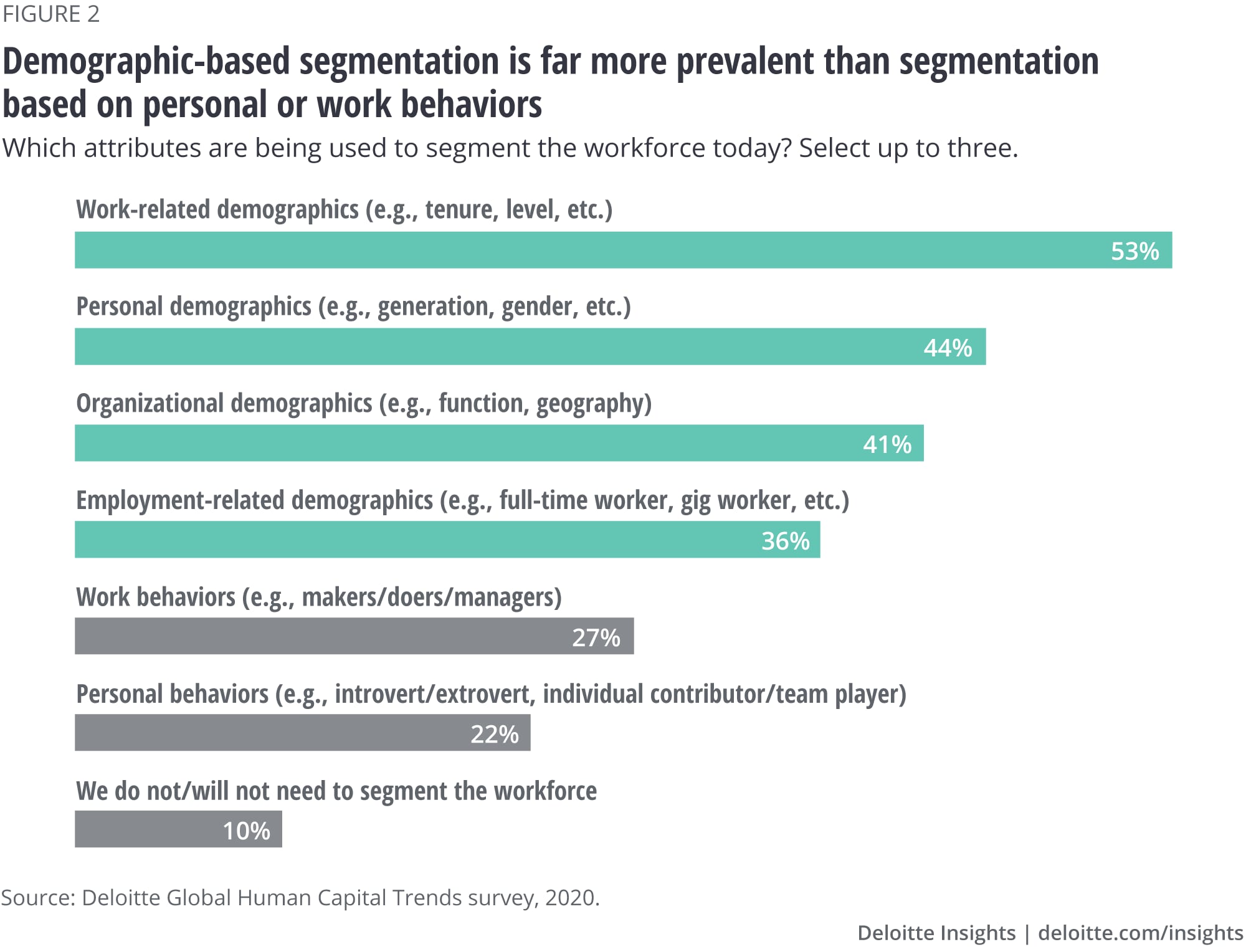
When organizations look at a broader set of attributes, they have an opportunity to understand individuals’ distinct characteristics to bring them together in ways that can promote a greater sense of belonging. Research from MetLife offers a view of how this can happen. MetLife identifies five factors that organizations should consider in workforce segmentation:
- Demographics such as age, gender, income, education, and life events
- Firmographics such as job tenure, company size, industry, role, and blue vs. white collar
- Attitudes toward life such as optimism toward the future, future vs. present orientation, orientation toward change, and sources of pleasure/stress
- Attitudes toward work such as work-life balance, attitudes toward retirement, and motivations for staying at the job
- Needs from employer such as career development support, salary, benefits, work culture, and work subject matter
MetLife says that segmenting based also on mindsets and attitudes enables a “more personalized, customized, and authentic” understanding of the workforce that can help leaders “focus dollars where they’re most impactful, because they know these programs have a direct emotional link to employee satisfaction.”6
The postgenerational workforce through the years in Global Human Capital Trends
Over the past decade, careers have become more dynamic and complex. People are living longer and working longer, and the rapid pace of change in the workplace has resulted in the need for workers to reinvent themselves multiple times throughout their careers. A key component to this has been the role of older generations of workers in the workplace. In 2013’s chapter, “The aging workforce: Finding the silver lining in the talent gap,” we recommended that organizations find ways to retain mature talent that create value for the organization without creating a “gray ceiling” that limits advancement opportunities for younger workers. We suggested that organizations look for opportunities to apply principles of workforce flexibility and career customization. Five years later, in “The longevity dividend: Work in an era of 100-year lives,” our call to action was the same: Organizations had an important opportunity to engage workers across generations through the creation of meaningful, productive multistage and multidimensional careers. This year, we suggest that to most effectively create those multistage and multidimensional careers, organizations should reconsider workforce strategies and programs based solely on age or generation and instead consider workers’ interests, values, preferences, and opinions to better tailor opportunities to workers’ individual attributes.
So where should organizations focus this new segmentation? Our 2020 survey data gives us some clues. Based on the research, we found that generation is, on average, used twice as often to inform policies and programs related to careers and learning compared to areas such as performance management, compensation, benefits, and well-being (figure 3). And that tells us a lot about where the biggest opportunities exist.
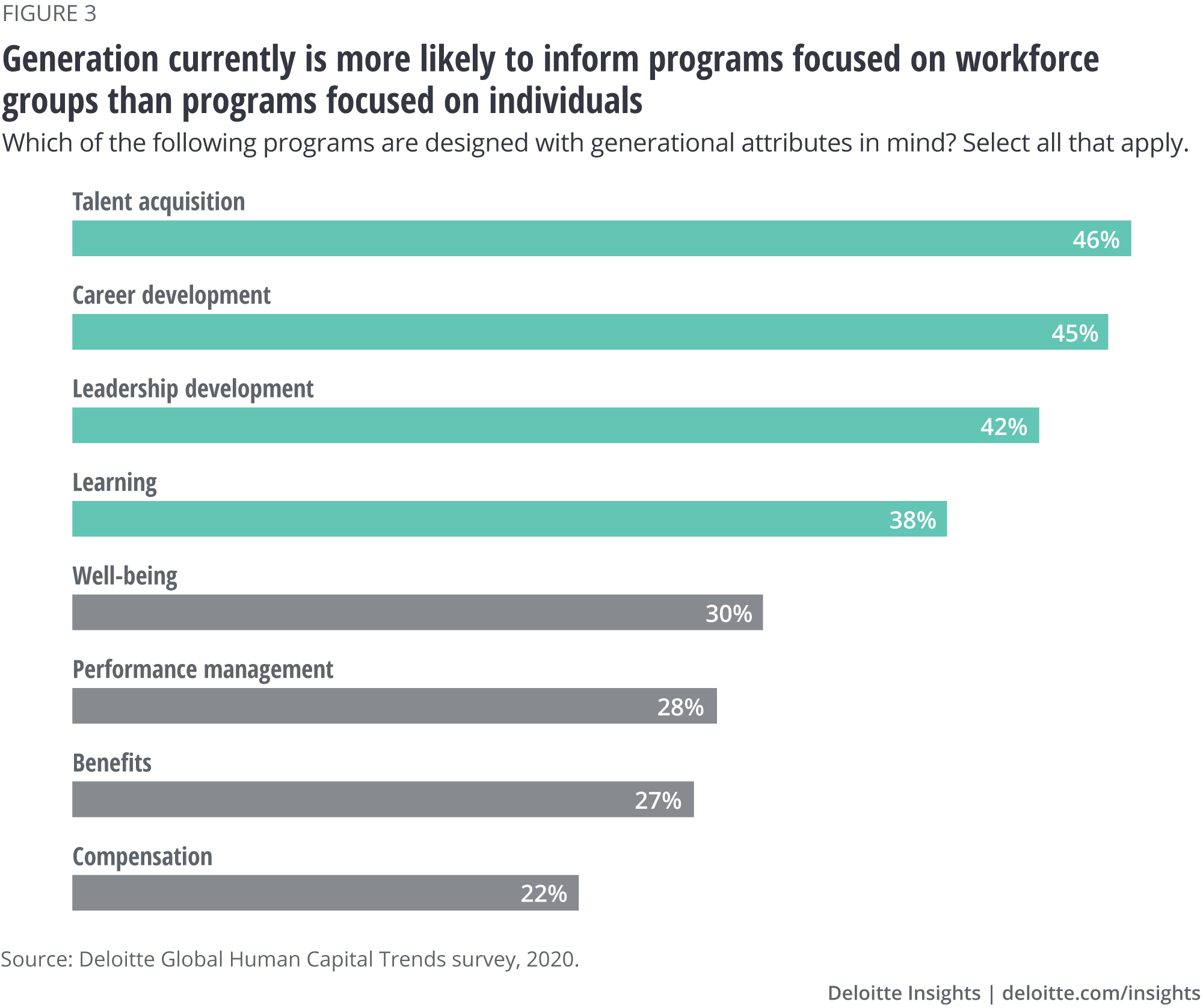
Well-being, performance management, benefits, and compensation have historically been focused on individual needs. Because of this, generational perspectives have been less relevant in the design of these programs. On the other hand, talent acquisition, career development, leadership development, and learning, which use workforce groupings and assumptions about demographics in their design and application, have relied much more heavily on generational perspectives. But as prior common stereotypes and assumptions—such as that older workers want to retire as early as possible, people require a certain number of years of experience to be a leader, or workers no longer need to develop once they have reached a certain tenure—increasingly prove incorrect, the proxy of generation becomes less relevant in these areas as well, providing an opportunity for new segmentation strategies and greater personalization.
When learning, leadership development, career development, and talent acquisition become more personal and more dynamic, their impact on business outcomes can be greatly enhanced. Imagine if, for example:
- Organizations designed career programs around work behaviors, enabling people who might be “makers” or “doers” (rather than managers) to still have robust career paths ahead of them. This can help organizations to retain their top talent at a time when the rate of disruption has made it more important than ever to retain individuals with the institutional knowledge to inform go-forward business strategies.
- Organizations created learning programs centered around workers’ learning styles and preferences, such as whether they learn best by experience, in the classroom, on their own, or in teams. This would enable them to develop in ways suited to their preferences—helping them to reskill and upskill faster to meet changing business needs.
- Talent acquisition programs recruited people based on their capabilities and attitudes toward work-life balance and where they are in their careers. This would help organizations broaden their talent pool by bringing in people at different ages and stages for different business and skill priorities, which is becoming increasingly important in today’s tight talent market.
- Leadership programs were organized around evolving individual capabilities, needs, and expectations, enabling more fluid movement across roles. This would help create the type of adaptable, team-oriented organization that aligns leaders to the way that work gets done, helping improve organizational outcomes and increase business success.
This perspective mirrors what London Business School professors Lynda Gratton and Andrew Scott wrote in The 100-Year Life, where they talked about the move from age to stage.7 Understanding workers’ values, attitudes, behaviors, and interests—and finding cross-cutting patterns that identify similar groups of workers—requires a nuanced approach that tailors workforce strategies through many different lenses. It demands that organizations find ways to measure, track, and respond to individual characteristics that are invisible to most organizations today. And it means equipping leaders to manage a far more complex segmentation than most organizations have historically maintained.
Learning by example
New research and profiling tools are disproving previous assumptions that certain work characteristics are tied to specific generations. For instance, enterprise software company Swarm Vision has created a psychographic profiler that can measure worker innovation talent based on eight skill clusters. Swarm Vision’s extensive research into the correlation between innovation, talent, and positive business results revealed an interesting finding—that age is not a driving factor of innovation scores. In fact, its research revealed very little (less than 5 percent) difference between age groups, proving that this demographic lens is not an appropriate proxy for understanding characteristics related to innovation.8 Applying a psychographic lens to talent in an organization’s workforce segments and teams and using that information to design new teams and upskilling programs could help to increase innovation output and ROI.
New technologies and techniques for collecting and analyzing workforce data will be critical to understanding distinct employee archetypes. A global energy company provides an example of how advanced analytics can help organizations segment the workforce in different and productive ways. The company used unsupervised learning algorithms to identify unique segments in its leadership population, looking for meaningful clusters (such as leaders with deep networks, high adaptability, or strong analytical capability) that cross-cut demographic categories. The company then compared these clusters to its high-potential leadership pipeline to determine whether certain geographies or employee cohorts were underrepresented in its leadership programs.9
Pivoting ahead
In large part, the millennial generation’s views and expectations were what originally pushed organizations to focus on generation as a way of understanding the workforce. Ironically, that understanding is now leading many organizations to the conclusion that segmenting by generation—or by any single demographic attribute—is an oversimplification. Organizations today have the opportunity to apply consumer marketing insights and data analytics to design workforce management practices based on a deep understanding of individual behaviors, values, and attitudes, as well as demographics and career and life stages. This postgenerational approach holds the potential for organizations to meet workers’ needs and expectations in ways that are more meaningful to them and more beneficial to the enterprise, paying ongoing dividends in enhanced engagement and performance.
© 2021. See Terms of Use for more information.
Explore the collection
-
Superteams Article4 years ago
-
Knowledge management Article4 years ago
-
Beyond reskilling Article4 years ago
-
The compensation conundrum Article4 years ago
-
Governing workforce strategies Article4 years ago
-
Ethics and the future of work Article4 years ago



